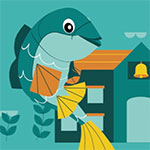Shore Fishing
Shore fishing offers many opportunities for anglers. You can fish from the banks of rivers and streams, the shorelines of lakes and ponds, and in the surf on the coasts.
Shore Fishing Tips
Once you learn a few simple tips about how to shore fish, you can find the shoreline of a local pond, river, lake or coastline and start catching fish. The main advantage of fishing from shore is that almost everyone has access to a spot that's close to home. Whether you are with family or friends, shore fishing is a great way for anglers of all skill levels to enjoy a day of fishing together.
Both freshwater and saltwater fish species can be caught from shoreline spots. Some of the freshwater fish species that are most commonly caught by shoreline anglers include largemouth bass, rainbow trout, bluegill, crappie, and catfish. Spotted seatrout, snook, croaker, bluefish, founder, and striped bass are a few of the saltwater fish species that you can catch from the shoreline.
Lakes And Ponds
The shoreline of a lake or pond is an easy place to start learning how to shore fish. Once you purchase a fishing license, assemble your freshwater fishing gear, and find a public lake or pond, you will be ready to fish. Keep these fishing tips in mind when learning how to fish the shoreline of a lake or pond.
- Shoreline structure such as docks, logs, vegetation, rock piles, and downed trees are ideal fishing spots. When you find structure, focus your fishing efforts in these areas.
- Walk around the lake or pond shoreline to find the best spots. Chances are the most productive areas will be more remote, farther from roads or busy areas. Shoreline spots close to a park entrance, for example, may produce fewer bites due to noise and fishing pressure.
- Cast your line parallel to the shoreline. While you may have the urge to cast straight out toward the middle of the lake or pond, most of the fish will be close to shore. If you can identify the spots where the shoreline drops off into the lake or pond, those are good areas to try.
Rivers And Streams
Freshwater rivers and streams are also good places to try shore fishing, particularly those with structure such as islands, sand bars, rock piles, or log jams. While rivers and streams can be a bit more challenging to fish because of stronger currents, these shore fishing tips will help you find the best spots.
- If you are learning how to shore fish the shoreline of a shallow river, you may want to try shallow-water wading. When you are positioned in the middle of a stream gives you more structure to cast to. Remember, most fish will face the current and wait for food to drift past.
- Locate areas where there is little to no current. In other words, find the backwaters of the river or stream. Most game fish prefer to stay away from areas with heavy current. Largemouth bass, for example, are one type of freshwater game fish that prefers calmer sections of a river.
Saltwater Coastlines
What if you want to visit a state such as Florida or California so that you can fish from a saltwater coastline? First, you will need to buy a saltwater fishing license. Then, you will have to decide if you want to cast your line out from a beach, fishing pier or bridge. It's not hard to learn how to shore fish from the coastline.
- If you plan to go surf fishing from a beach, look for shallow sloughs, pockets, tidal currents, and other areas where fish (and baitfish) may be present.
- When saltwater pier fishing, remember that most piers are built with rock piles or other structure nearby to attract fish. However, don't forget that aside from rock piles or other structure, the pier pilings themselves will attract fish. In fact, some of the best fishing is often right underneath a pier.
- Bridges can be good places to learn how to shore fish near a saltwater coastline. Bridges provide shelter and protection for many inshore saltwater species. One of the most important tips to remember when bridge fishing is to use heavier leader material that will hold up to abrasive pilings or edges.
Now that you have some new tips for shore fishing in freshwater and saltwater situations, you can grab your fishing gear and get started. If you need more tips and suggestions, visit the "How To Fish" section.
KEEP LEARNING

First Catch Center Trailer Gallery
FCC Trailer Photo Gallery
LEARN MORE

How to Tie a Duncan Knot
Learn to tie a Duncan knot by following these five simple steps. Watch our new video.
LEARN MORE

Welcome to Angler Academy!
No one said you can’t bring fishing inside! There’s lots of fun activities we can do right from home
LEARN MORE


.png?lang=en-US&ext=.png)